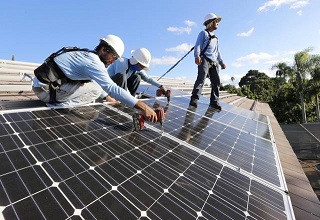From Guest Blogger Emily Folk: How to Lower the Costs of Residential Renewable Energy

But when it comes to switching over to solar or wind power or buying an electric car, going green is out of reach for many people. The prices of electric cars are dropping but are still out of the price range for the average consumer.
You’d like to run your house on solar power, but this is also financially out of reach for most people. Converting your house to solar power could cost over $30,000.00, depending on the size of your home and its location.
And it’s unlikely you will be installing a wind turbine to power your home. Wind turbines cost over $50,000 and require professional installation. It’s a nice thought, but not practical for most Americans.
Until we make renewable energy accessible and affordable, our country will have to rely on fossil fuels for our energy needs. In the meantime, we can focus on ways to cut the cost of renewable energy so that more people will be able and willing to make the financial investment to go green.
Cut Red Tape
Americans pay twice as much for solar energy than people overseas. The costs are incurred because of our overregulation of the solar energy business. Codes, permits and tariffs add up to energy costing $3.25 per watt in the United States versus $1.34 in Australia. However, through 2019 in the U.S. there is a federal tax credit of 30% on solar panel installation.
While we want our products to be safe and installed professionally, overregulation makes solar power less accessible and less affordable. We should invest our money in the industry, not in government regulators who slow down the implementation of solar energy.
The only way for the consumer to affect this process is to contact their elected officials and lobby them to make changes. Our laws are supposed to protect us, not prevent us from making environmentally conscious choices.
Integrated Solar Roofing
Instead of having solar panels on your roof, your roof would be the solar panels. Integrated roofing could cut the costs of both your roof and your solar panels by combining their efforts into one system.
Unfortunately, you would have to make the investment somewhere, so it’s not as practical for someone in a home which is already built. But new homes could be built with integrated roofs as a standard practice. This would save on the initial investment most people have to make.
Reduce Hardware Costs
We can lighten our electric load by getting rid of inefficient energy hogs such as our old refrigerators and air conditioning systems. These waste electricity by requiring more than what is needed to do the job. There are newer appliances which require much less energy and produce the same results. Switching to Energy Star compliant refrigerator can reduce your energy use by up to 75 percent.
Reducing your energy demands will reduce the number of solar panels or wind turbines required to power your home. Technology is advancing, and costs are coming down.
Wind turbines are more efficient than even two years ago. The rotors are designed with larger diameters so they can capture more wind. The turbines have higher hub heights so they can reach the steadier winds at higher altitudes. These changes helped wind turbines generate over 10 percent more power than before.
If the industry can continue to reduce hardware costs, then more people will be able to buy solar panels and wind turbines.
Most of us are willing to do our part to save energy and reduce waste. We can reuse, reduce and recycle our products as much as possible. We can pick up trash and commit to not polluting our environment. We can support mass transit and walk and ride our bikes whenever we can. We want our children and grandchildren to live on a healthy earth with clean air and water.
But we rely on our government and our industries to find ways for us to harvest renewable energy. For most of us, the purchase of an alternative energy system to power our home is financially out of reach. Who wouldn’t want to brag about powering their home off of a wind turbine or rooftop solar panels? We would do it if we could.
As technology improves and becomes more efficient, the costs will come down. More of us will be able to make the investment to go green and reduce our reliance on hostile foreign governments and fossil fuels. Hopefully, we can get there before we encounter another energy crisis.
